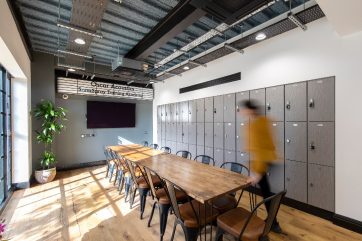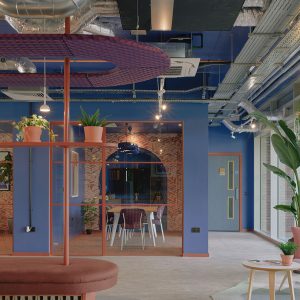
Words by: Ben Hancock, Managing Director, Oscar Acoustics
The past year has set the stage for transformative trends that will shape office spaces in the coming months, balancing the needs of an office-led workforce with the imperative for environmentally conscious design.
Retrofitting for regulations and wellbeing
The shift towards creating ‘home-away-from-home’ environments has gained momentum, with thoughtful design and planning becoming essential in attracting employees back to the office. Features like breakout rooms, private nooks, and high-quality amenities are now critical in fostering comfort, community, and creativity.
Recent JLL research reveals that employees are averaging 3.1 days per week in the office, with a strong desire for non-traditional spaces that support concentration (47%), energy restoration (40%), and desk alternatives (39%).
Our Oscar Innovation Centre exemplifies this balance, featuring an open-plan layout with low-level background music for team interaction, complemented by sliding glass doors for privacy. This design accommodates the diverse needs of the modern workforce, from collaborative sessions to focused individual work.
 Image Credit: Antonia Stuart
Image Credit: Antonia Stuart
Sustainability as a value driver
Looking ahead, we anticipate a significant investment in retrofitting older buildings to comply with tightening EPC regulations. This trend presents an opportunity for asset and building owners to enhance comfort and overall well-being while transforming outdated offices into vibrant, future-ready spaces aligned with contemporary workforce needs.
Sustainability will continue to be a key value driver in 2025.
The past year has seen a shift towards measurable, verified practices, moving away from vague claims like ‘carbon-neutral’. We expect contractors to invest more in their sustainability departments to better understand and document environmental impacts. Commercial spaces meeting environmental benchmarks such as BREEAM or LEED certifications will likely command higher property values and attract premium tenants. Green offices with ‘outstanding’ or ‘excellent’ BREEAM ratings are showing significantly lower vacancy rates compared to their less sustainable counterparts.
Fire safety also remains a critical focus for commercial properties. As regulations evolve, property owners must prioritise safety measures in both new builds and existing structures, carefully considering materials and finishes to ensure compliance and peace of mind for occupants.
 Image Credit: Antonia Stuart
Image Credit: Antonia Stuart
Lessons, made learnings
The commercial workplace sector has demonstrated resilience in adapting to regulatory changes, though not without challenges. Many companies, especially SMEs, have faced rising costs and unexpected expenses. In this environment, maintaining financial discipline and building reserves are crucial for business resilience.
Our own approach at Oscar Acoustics is informed by past lessons. After experiencing rapid growth followed by significant challenges, we’ve spent the last year preparing for sustainable expansion. Our focus has been on stability, bolstering our teams, and investing in infrastructure and training facilities to maintain high standards as we grow.
As we look to 2025, our priority is rebuilding reserves to safeguard against potential challenges while positioning ourselves for long-term success. The commercial workspace of 2025 will be characterized by adaptability, sustainability, and a keen focus on employee well-being, setting the bar for a new era of workplace design and functionality.





